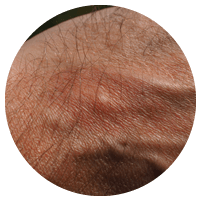Allergy or Intolerance?
Allergies and intolerances explained
Allergies and intolerances explained
Can’t decide if you have an allergy or a sensitivity? Check out our information and facts below. At Test My Food Sensitivity, we help people to learn their sensitivities and intolerance (food and non-food) every day, creating a happier and healthier person.
The majority of allergies are hereditary and you will most likely be allergic to certain items for life. On the other hand, a sensitivity can and does change depending on your diet and lifestyle. The good news though is you can work with your food sensitivities to reduce them and even overcome them.
If your body is not digesting a certain item properly, then you have an intolerance to that particular item. This could be either a foodintolerance or an environmental factor (a non-food intolerance). Take a look at the two most commons reasons you might have an intolerance to a particular item:
The body is lacking the necessary digestive enzymes(s) for the certain food and therefore cannot digest the item properly or efficiently take the nutrients from it.
Alternatively, are you eating too much of the same thing? Many symptoms are the result of a sensitivity to a particular item. A sensitivity can occur from overconsumption or overexposure of an item.


Allergies are detected by measuring the Immunoglobulin E count (IgE) in the blood, as these are specific blood cells that help to combat allergies. If you have an allergy to a particular food or non-food item, your body will begin to react the moment it comes into contact with it.
Allergy’s present themselves in various ways which severely impact our body. Ranging from localised swelling to a rash or even having difficulty breathing, these allergic reactions can affect our daily routine.
Common allergic reactions can include localised swelling (i.e. of the throat or tongue), a rash, or difficulty breathing. Peanut, shellfish, egg and soya are among some of the most common allergens.
By comparison, an intolerance is not as severe and immediate as an allergy. These symptoms come on gradually; anything from 30 minutes up to 72 hours later. These symptoms might include headaches, bloating, localised itching or skin irritations such as eczema, excessive mucous production, excessive gas, diarrhoea, and fatigue.
Peanut, shellfish, egg and soya are among some of the most common food allergens, so be careful and make sure you get tested!
IgG4 food sensitivities are generally less severe than IgE food sensitivities and typical symptoms can include; headaches and nausea, seizures and hyperactivity.
These may occur hours or even days after the offending food has been ingested. The degree and severity of symptoms vary because of the genetic makeup of the individual. IgG4 food sensitivities are generally treated by removing problem foods from the diet and by helping digestion with probiotics.


However, you may just have an intolerance to a food, meaning if managed carefully, you can still consume the particular product. An intolerance is not as severe and immediate as an allergy. These symptoms come on gradually; anything from 30 minutes up to 72 hours later, but this does make the culprit harder to catch.
Like an allergy, there is a range of symptoms, and they may also have a severe impact on your body. These symptoms might include headaches, bloating, localised itching or skin irritations such as eczema, excessive mucous production, excessive gas, diarrhoea, and fatigue. So again, it is essential that you take a test!
The body is lacking the necessary digestive enzymes(s) for the certain food and therefore cannot digest the item properly or efficiently take the nutrients from it.
A sensitivity resulting from over-consumption or overexposure?Alternatively, are you eating too much of the same thing? Many symptoms are the result of a sensitivity to a particular item. A sensitivity can occur from overconsumption or overexposure of an item.

The most common method of diagnosing allergies is with a simple blood test, usually testing the IgE or IgG levels in the blood. Typically, IgE allergies are immediate responses to when a foreign substance that has entered the body.
Where do they come from though? These foreign substances can come from food or can come from inhalation. IgE allergies can cause very serious symptoms like difficulty breathing, swelling, and hives. In even more serious cases, IgE reactions can lead to anaphylactic shock.
Allergy’s present themselves in various ways which severely impact our body. Ranging from localised swelling to a rash or even having difficulty breathing, these allergic reactions can affect our daily routine.
Common allergic reactions can include localised swelling (i.e. of the throat or tongue), a rash, or difficulty breathing. Peanut, shellfish, egg and soya are among some of the most common allergens.
By comparison, an intolerance is not as severe and immediate as an allergy. These symptoms come on gradually; anything from 30 minutes up to 72 hours later. These symptoms might include headaches, bloating, localised itching or skin irritations such as eczema, excessive mucous production, excessive gas, diarrhoea, and fatigue.
IgG4 food sensitivities are generally less severe than IgE food sensitivities and typical symptoms can include; headaches and nausea, seizures and hyperactivity. These may occur hours or even days after the offending food has been ingested. The degree and severity of symptoms vary because of the genetic makeup of the individual.
Ultimately, it is not a complete disaster! IgG4 food sensitivities are generally treated by removing problem foods from the diet and by helping digestion with probiotics.
IgG4 food sensitivities are generally less severe than IgE food sensitivities and typical symptoms can include; headaches and nausea, seizures and hyperactivity. These may occur hours or even days after the offending food has been ingested. The degree and severity of symptoms vary because of the genetic makeup of the individual. IgG4 food sensitivities are generally treated by removing problem foods from the diet and by helping digestion with probiotics.
Discover the cause of your symptoms and start a path to better wellness with Test My Food Sensitivity today: Order now.